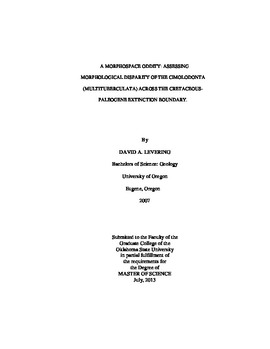| dc.contributor.advisor | Levering, David A. | |
| dc.contributor.author | Levering, David A. | |
| dc.date.accessioned | 2014-09-24T14:18:33Z | |
| dc.date.available | 2014-09-24T14:18:33Z | |
| dc.date.issued | 2013-07-01 | |
| dc.identifier.uri | https://hdl.handle.net/11244/11166 | |
| dc.description.abstract | In this study, I focus on the loss of species diversity - and therefore morphological diversity - within the Cimolodonta (Multituberculata) during the Cretaceous-Paleogene (K-Pg) extinction, followed by their recovery in the Puercan (earliest Paleogene). Teeth make up the majority of the cimolodontan fossil record, allowing inferences of dietary ecology, body size estimates, and phylogenetic proximity. I analyzed morphological disparity within the restricted phylogenetic framework of the Cimolodonta. I addressed 3 questions: 1) Did the conditions of the K-Pg extinction select for or against cimolodontan dental morphologies, if it was selective at all? 2) Do levels of cimolodontan morphological similarity return to pre-extinction levels in the Puercan? 3) Do the Puercan Cimolodonta recover morphology lost during the extinction, or do the Cimolodonta morphologically diverge from the pre-extinction morphospace? I used Euclidian inter-taxon distance measures derived from dental character data to perform a principal coordinates analysis (PCO), generating a multidimensional representation of morphological similarity. To assess the selectivity versus non-selectivity of cimolodontan extinction across the K-Pg boundary, I analyzed the axes of the morphospace for morphological character gradients. I tested for extinction selectivity to determine the probability of generating the survivor-specie morphospace by chance. These results indicate significant (P = 0.0006) selection affecting cimolodontan survival across the K-Pg extinction. Overall morphospace occupation changed significantly (P < 0.015) in the Puercan as well. I attribute this change in morphospace occupation to the diversification of the Taeniolabididae and incomplete recovery of Late Cretaceous morphospace by the Puercan Cimolodonta. Vacancies in the Puercan cimolodontan morphospace may be a result of changes in available dietary resources, or competitive exclusion. The Taeniolabididae occupy a morphospace region distant from the remainder of the Puercan Cimolodonta, supporting independent studies suggesting they were an immigrant taxon rather than a product of rapid phenotypic divergence. My results indicate selection taking place over the K-Pg extinction for small body size within the Cimolodonta. I also find evidence of partial reoccupation of Late Cretaceous cimolodontan morphospace in the Puercan, indicating ecological niche recovery. | |
| dc.format | application/pdf | |
| dc.language | en_US | |
| dc.publisher | Oklahoma State University | |
| dc.rights | Copyright is held by the author who has granted the Oklahoma State University Library the non-exclusive right to share this material in its institutional repository. Contact Digital Library Services at lib-dls@okstate.edu or 405-744-9161 for the permission policy on the use, reproduction or distribution of this material. | |
| dc.title | Morphospace Oddity: Assessing Morphological Disparity of the Cimolodonta (Multituberculata) Across the Cretaceous-Paleogene Extinction Boundary. | |
| dc.type | text | |
| dc.contributor.committeeMember | Luttbeg, Barney | |
| dc.contributor.committeeMember | Weil, Anne | |
| dc.contributor.committeeMember | Van Den Bussche, Ron | |
| osu.filename | Levering_okstate_0664M_12795.pdf | |
| osu.accesstype | Open Access | |
| dc.description.department | Zoology | |
| dc.type.genre | Thesis | |
